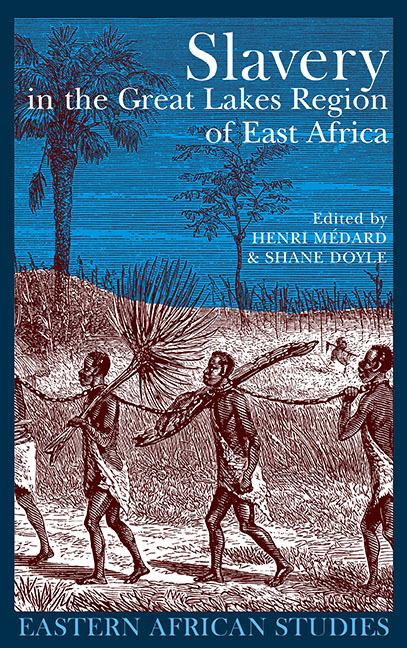Book contents
- Frontmatter
- Dedication
- Contents
- List of Maps & Tables
- Notes on Contributors
- Introduction
- 1 Violence, Marginality, Scorn & Honour: Language evidence of slavery to the eighteenth century
- 2 Notes on the Rise of Slavery & Social Change in Unyamwezi c. 1860 –1900
- 3 Slavery & Forced Labour in the Eastern Congo 1850 –1910
- 4 Legacies of Slavery in North West Uganda: The story of the ‘One-Elevens’
- 5 Human Booty in Buganda: Some observations on the seizure of people in war c.1700 –1890
- 6 Stolen People & Autonomous Chiefs in Nineteenth-Century Buganda: The social consequences of non-free followers
- 7 Women's Experiences of Enslavement & Slavery in Late Nineteenth- & Early Twentieth-Century Uganda
- 8 Slavery & Other Forms of Social Oppression in Ankole 1890 –1940
- 9 The Slave Trade in Burundi & Rwanda at the Beginning of German Colonisation 1890 –1906
- 10 Bunyoro & the Demography of Slavery Debate: Fertility, kinship & assimilation
- References
- Index
5 - Human Booty in Buganda: Some observations on the seizure of people in war c.1700 –1890
Published online by Cambridge University Press: 11 August 2017
- Frontmatter
- Dedication
- Contents
- List of Maps & Tables
- Notes on Contributors
- Introduction
- 1 Violence, Marginality, Scorn & Honour: Language evidence of slavery to the eighteenth century
- 2 Notes on the Rise of Slavery & Social Change in Unyamwezi c. 1860 –1900
- 3 Slavery & Forced Labour in the Eastern Congo 1850 –1910
- 4 Legacies of Slavery in North West Uganda: The story of the ‘One-Elevens’
- 5 Human Booty in Buganda: Some observations on the seizure of people in war c.1700 –1890
- 6 Stolen People & Autonomous Chiefs in Nineteenth-Century Buganda: The social consequences of non-free followers
- 7 Women's Experiences of Enslavement & Slavery in Late Nineteenth- & Early Twentieth-Century Uganda
- 8 Slavery & Other Forms of Social Oppression in Ankole 1890 –1940
- 9 The Slave Trade in Burundi & Rwanda at the Beginning of German Colonisation 1890 –1906
- 10 Bunyoro & the Demography of Slavery Debate: Fertility, kinship & assimilation
- References
- Index
Summary
Introduction: Prisoners-of-War or Slaves Forever More?
Slavery and warfare were indelibly intertwined in the nineteenth-century Ganda kingdom (see Map 3), part of the process by which Buganda sought to impose itself on the surrounding region, effect commercial control over its neighbours’ economies, achieve external security as well as internal cohesion, and develop its own peculiar form of ‘national identity’. Slavery as an institution was fundamental to the effective functioning of the internal political and economic systems; slaves also became, after the 1850s, Buganda's primary commercial export. Slaves themselves were, at least in part, a product of the cycle of expansionism which had been operative since the seventeenth century. War was the vital instrument in the acquisition of slaves for both the internal and the external market. It should be observed, however, that the Ganda rarely waged war for the sole purpose of acquiring slaves: their military policy, indeed their entire military ethos, was much more complex than this. War was a method of achieving political and economic dominance, and of controlling and maximising use of regional resources. But more than this, warfare underpinned Ganda identity. Many of the signs and symbols of Ganda national identity were to be found in the kingdom's highly sophisticated military culture, which glorified the bearing of arms and emphasised the Ganda people's superiority over their neighbours, which in turn justified the fact that the bulk of the slaves in Ganda possession were drawn from those same neighbours. The violence of the Ganda state, therefore, was both explicit – in its celebration of the achievements of war – and implicit – in the integral belief in the right of the Ganda to dominate and enslave surrounding peoples.
Extensive slave-ownership in Buganda undoubtedly developed in parallel with the kingdom's expansion during the seventeenth and eighteenth centuries to the point of regional dominance. It may reasonably be supposed that during the same period the complexities of the slave system also developed, including the emergence of slave hierarchies and divisions of labour within the broad institution of slavery itself. It is not a straightforward matter to define who or what constituted a ‘slave’ in the nineteenth-century kingdom.
- Type
- Chapter
- Information
- Slavery in the Great Lakes Region of East Africa , pp. 145 - 160Publisher: Boydell & BrewerPrint publication year: 2007



